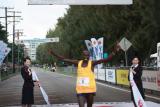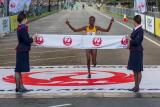Folders |
Honolulu Marathon Recap 2016 - Ian TsangPublished by
A front row seat for Cherono's record run in Honolulu By Ian Tsang for DyeStat Shots rang out early Sunday morning as if a million guns were firing simultaneously, signaling the start of the Honolulu Marathon. Most races are started with the traditional gun, however marathons in Hawaii – host to the fourth-largest event in the U.S. behind New York, Chicago, and Boston – like to put on a show. Fireworks blazed through the air and lit up the sky, setting off loud explosions for miles as they reached their peak. I had the unique opportunity to represent my organization "The Hawaii Project" and see the race from a rare perspective. Paired with association president Jim Barahal, agent Davor Savija and other media personnel, we drove the entire time just ahead of the marathon leaders with a prime view for taking pictures, videos and splits. The conditions were surprisingly more than ideal. Usually Honolulu is known for its intense humidity that breaks down the athletes in the race’s later stages, but the cloud coverage and early start gave a 65-degree real feel that put the elites in a mindset that would help them attack the course record. Race rabbit Festus Talam went out quick to settle in to record pace. He led a pack of nine athletes through the first kilometer in 3 minutes, and eventually through the opening mile in 4:56. Recent Olympic silver medalist Feyisa Lilesa of Ethiopia tucked into the middle of the pack as Wilson Chebet – the 2014 race winner and last year’s runner-up – followed suit. Lilesa was the pre-race favorite to win gold because of his PR of 2:04.52, fastest of all entries. But he was recovering from illness and didn’t have the confidence he could control the race. "I couldn't do well in the race, I was not really relaxed," Feyisa said. Feyisa posed the biggest threat to the dominance the Kenyans, who have won every single title during the past two decades except in 2006, which was won by Ethiopian Ambesse Tolossa. Throughout the race Feyisa was quite unpredictable, fluctuating between the lead pack and chase group at least 5 meters behind. His inconsistent race could be because of his choice not to hydrate throughout as much as his competitors. Every few kilometers, there were places called "elite stations" where athletes pre-made drink concoctions available for them in an easy to consume squeeze bottle that would help keep their momentum despite taking a detour. Most other runners made the extra stride to hydrate at these stations, but Feyisa did not. At the second elite station, while rounding a corner, Talam – whose job was to stay in until 30 kilometers – swung tight and took a fall. He popped back up immediately and sprinted to the front where he made sure no one was pushing the effort too hard, resulting in a 3:05 split for that kilometer. In order to break the course record of 2:11:12 set in 2004 by Kenyan Jimmy Muindi, runners needed to average approximately 3:05 per kilometer for the whole race. Their bold efforts to take the race out perfectly on pace resulted in a 3-mile split of 14:52, followed by 15:26 through 5 kilometers. Shortly thereafter, the only non-African athlete in the field, Yusei Nakao of Japan, dropped off the leaders’ pace at approximately the 24-minute mark, with his 2:13:23 personal best not allowing him to maintain his early speed. As the remaining runners approached the 10-kilometer mark, everyone formed two lines and drafted off one another, creating a pack mentality. Through the halfway mark, nearly the entire lead group came through in 1:05:10, on pace to shatter the course record by a large margin with mile splits averaging 5:00-5:05. The 11th mile was completed 5:10, historically known for drastically slowing the pace since it provides the largest climb up the monumental Diamond Head Mountain. After the grueling climb, the lead group approached another elite aid station which, after they rounded a gradual right turn, descended a steep downhill that would help them make up for lost time from the ascent they had just made. The race scenery switches at this point from the urban setting of the downtown Waikiki area to the residential areas in the outer parts of the island. After a few more miles on flat ground, runners made a detour that took them back in direction from which they came. From this point, it was quite evident that the record would be broken, especially after the male leaders passed the women’s elite marathoners on the other side of the road. As the race reached the latter stages, the lead pack thinned out, with the top contenders including Lilesa and fellow Ethiopian Deribe Robi, along with Kenyans Lawrence Cherono and Chebet. Lilesa continued to fall further back as the race progressed, to the point where he wasn’t visible anymore. Robi also fell off the pace eventually until it was nothing but the two Kenyans and the 30,000 other runners passing mile marker No. 8 on the opposite side of the road. It became a battle to the finish, a thrilling duel between countrymen that decided who would take home the grand prize $40,000 of the $150,000 overall purse. Cherono was the first to surge, gaining a seven-second lead over Chebet, resulting in the 20th mile being timed in 4:47 and the ensuing mile in 4:54. But as the pace slowed, Chebet gained more ground and soon they were again running stride for stride. Seeing that Wilson had just used significant energy to catch up, Cherono then dropped the hammer by covering the 23rd mile in 4:40, gaining a 25-second lead over his countryman. The gap only grew wider as he confidently completed the next few miles. Around the 25th mile, the media truck sped up and drove directly toward the finish line. After two minutes of eagerly waiting for Cherono to cross the line, he finally did in a course-record 2:09.39, shattering Muindi’s 12-year-old standard by more than 90 seconds, a tribute to the favorable conditions and pacing job of Talam. Chebet repeated his same second-place finish from last year, clocking 2:10:49, also under the previous course record. Robi ran 2:13:39 for third, with Lilesa placing fourth in 2:15:16, demonstrating the same gesture of crossing his arms to indicate an ‘X’ which he also showcased winning his silver medal in Rio. Lilesa might have been the predicted winner who didn’t perform to his highest capability, but even with the unspoken rivalry involving the Kenyans and Ethiopians, he walked in with a handshake and hug for every one of the athletes who finished before him. In the future, Barahal aspires to have athletes run faster on the Honolulu course, or adjust the course in an effort to produce times in the 2:06 range. Either way, the future is bright for an event which, for the first time, proved it could be taken to the next level. |














